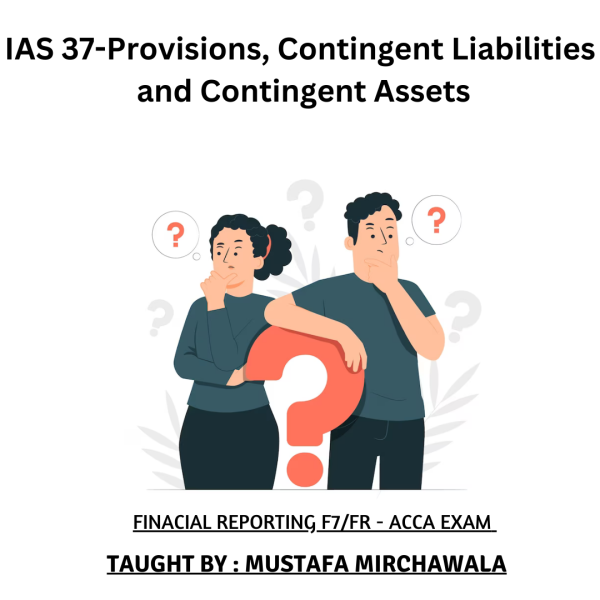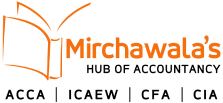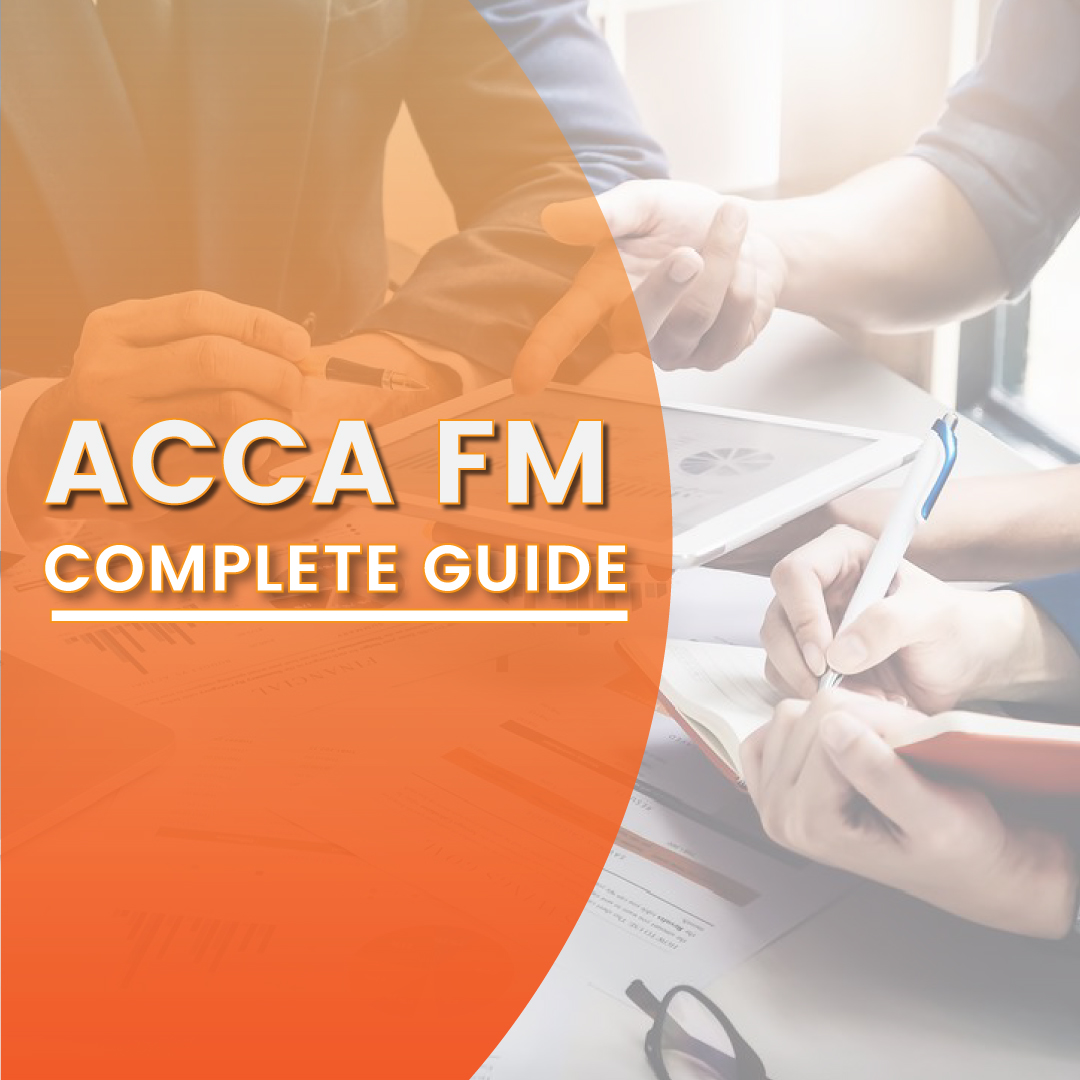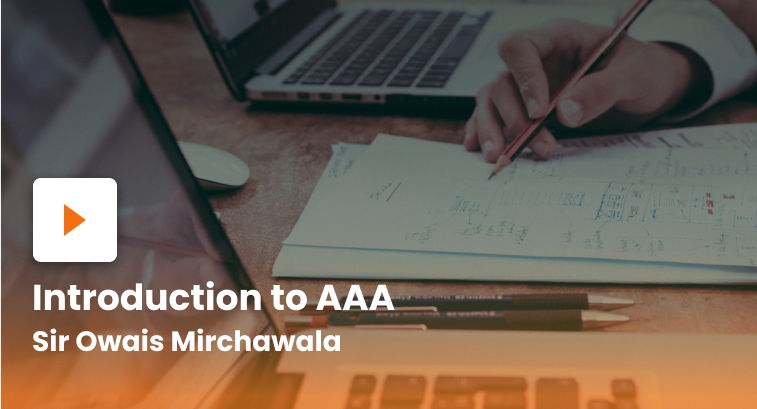ACCA FR/F7, Ulitimate Guide-Provision,Contingent Asset & Liabilities – IAS 37
This blog has been written to entitle you to a comprehensive perception of IAS 37, which is the keystone of Financial Reporting taught by Mustafa Mirchawala at Mirchawala’s Hub Of Accountancy

Accounting Before IAS 37
Before the introduction of IAS 37 in the financial world, businesses faced problems recognizing and reporting contingent assets, contingent liabilities, and provisions. The absence of regulations and suggestions caused great outcomes for studying monetary statements. This erodes the belief of international investors to invest money in various entities.
Introduction to IAS 37
In this environment of ambiguity, IAS 37 was introduced, which gives a signal and sets the guidelines and basis for the measurement and recognition of provisions, contingent liabilities, and contingent assets. IAS 37 was introduced in 1998 by the International Accounting Standards Committee.
Understanding IAS 37: All You Need to Know
IAS 37, issued by International Financial Reporting Standards (IFRS), gave guidelines and measurement criteria for provisions, contingent assets, and contingent liabilities. Let’s delve into some of the key terms:
Understanding Provisions
Provisions are liabilities of uncertain timing or amounts, according to IAS 37. These are the amounts set aside in the prediction of future expenditures. IAS 37 provides the criteria for the recognition of provisions. The measurement criteria include:
- Provisions should be recognized when the entity has a present obligation. The present obligation is either legally or constructively a result of past events. Legally, which is enforceable by law or statutory requirements. A constructive obligation can be a result of an entity’s past practice or any policies. They are imposed by law. A constructive obligation arises when the customer has expectations from his supplier.
- An example of a constructive obligation is that if ABC Company has a practice of refunding customers for defective products, it may have a constructive obligation to continue this practice. Companies should carefully determine whether the criteria for provisions are according to IAS 37 or not.
- The second recognition criterion is probable outflow. In accounting language, probable means when there is more than a 50% chance that an outflow of resources will be required to settle the commitment. To make it more clear, companies have to use their assets or the source of economic benefits to fulfill their obligation.
- The last condition for provisions is a reliable estimate. It must be met to recognize provisions correctly and precisely. A reliable estimate means the company managers can decide the appropriate amount to settle the liability. The company can use all the available information to decide the amount. Reliable estimates should be calculated by using the probability of all possible outcomes. To sum up, a reliable estimate requires evaluation to know the financial amount needed to settle the obligation.
Thus, if companies meet these conditions for the settlement of provisions, there will be more accuracy in their financial statements. It will lead to more clarity. Companies can do better strategic planning by applying IAS 37.
For some ACCA candidates, specific IFRS® standards are more favoured than others. IAS® 37, Provisions, Contingent Liabilities and Contingent Assets appears to be less popular than other standards because, usually, answers to Financial Reporting (FR) questions require a balanced discussion of whether criteria are met, as opposed to calculating numbers. However, IAS 37 is often a key standard in FR exams and candidates must be prepared to demonstrate application of the criteria .read more
Contingent Liabilities
Contingent liabilities are liabilities that have the capacity likely to occur in the future. Contingent liabilities should be recorded to make sure the financial statements are accurate and completely follow the guidelines of IFRS.
- A present obligation, For contingent liability, there must be a present obligation resulting from any past events. The obligation can arise from any legal actions taken, contracts for payment to a supplier, or a warranty.
- The likelihood of an outflow of resources is low; it is not probable that an outflow of assets will be required to settle the liability. Probable means that the chances are greater than 50% that an outflow of resources will be required to settle the liability. Companies should assess all the evidence and information related to contingent liability.
- Reliable estimate: the amount of the obligation cannot be measured reliably. Contingent liabilities are not recognized in the financial statements.
- Remote contingent liabilities are not disclosed in the financial statements because their likelihood of occurrence is improbable.
- Possible contingent liabilities are those that, when there is some uncertainty, are also not recognized in the financial statements. However, they should be disclosed with financial effect to inform company owners about the prospective risks.
Contingent liability examples include product damages, the warranty of products, lawsuits, and pending cases.
To wrap up, contingent liabilities should not be recognized in the financial statements; they should be revealed in the notes. Disclosure and recognition depend on their chances of occurring. Remote liabilities should never be disclosed or recognized. Only the possible one is to be disclosed in the notes.
Contingent Assets
A contingent asset is an asset that has the potential to generate economic well-being for the company in the upcoming times. IAS 37 has also provided the measurement criteria for the recognition of contingent assets. Let’s read out some points to understand contingent assets:
- Contingent assets are uncertain. This means they live in a state of uncertainty. Their occurrence or non-occurrence depends on future events.
- For contingent assets, there are recognition criteria. If it is probable, it will not be recognized in the financial statements but will be disclosed in the notes to the financial statements when the company knows that the inflow of economic benefit has a greater than 50% chance.
- If the inflow of economic benefit is virtually certain, that means closer to 100%. This indicates the occurrence of uncertain events are likely to happen. In this case, IAS 37 allows the organization to recognize these assets in the statement of financial position.
- If the amount is virtually certain, the amount of the asset should be measured. The organizations should make a reliable estimate of the asset’s value.
- Examples of contingent assets include: Legal claims, If the company is involved in any legal matter and if the company knows the decision will be in the company’s favor, the settlement amount will be considered virtually certain and recognized as an asset. A company named BJF has an asset with a probable tax refund of $20,000. This asset constitutes the predicted return from overpaid taxes, with a 75% chance of approval by tax authorities. Since the chances are probable, BJF should disclose the contingent asset in their financial statements.
Remember, businesses that don’t apply for IAS 37 may face some consequences. The investor’s belief relies on true and accurate financial statements. This may decrease their investors’ confidence. There is a regulatory risk when not applying IAS 37, which may lead to some penalties or fines.
Dear students, at Mirchawala’s Hub of Accountancy, you will always be supported both in the academic world and in the creative world. Blog writing offers a striking opportunity to not only express your ideas and thoughts but also earn income through it. If you are interested in writing a blog for us, read more
Conclusion
International Accounting Standard (IAS) 37 plays an essential part in the financial world. It is a set of guidelines or a framework that tells an organization how to measure, disclose, and recognize provisions, contingent liabilities, and contingent assets. Its significance extends beyond the domain of accounting because it plays a vital role in promoting transparency, accountability, and other good components.
Frequently Asked Questions FAQs
How does IAS 37 shape the accounting landscape?
Consistency, When IAS 37 came into the accounting world, it provided a standardized framework that made sure every company and the entities of every country applied similar principles. Today, IAS 37 is adopted by many countries around the world. This stability investor confidence.
The prudential concept in IAS 37 also encourages prudent accounting in the way that liabilities are recognized when the chances are probable, uncertain timings, or uncertain amounts. This practice prevents the minimization of financial statements.
Compliance with legal laws, One benefit of IAS 37 is that companies comply with legal regulations. It also ensures compliance with the International Financial Reporting Standard (IFRS), which helps them in many ways and thus lowers the risk of legitimate arguments.
Corporate governance, This framework of IAS 37 aligns with the principles of corporate governance, which include accountability, transparency, and reliable financial statements. Therefore, IAS 37 advances trust in financial statements.
Where can I find additional study resources or examples to improve my understanding of this topic?
Look for ACCA study materials, textbooks, and online resources to find more examples and exercises to strengthen your knowledge of provisions, contingent assets, and contingent liabilities. If you are a Mirchawala student contact us and we will assist you further
About author
I am Ruqaiya Imran, a student of MHA, currently studying FBT, FMA, and FFA. I am a content writer who loves to express ideas on related topics. My passion is continuous learning. I hope you will like this blog.












[…] is Bad Debts ? & what happens when a Read more October 13, […]
generic cialis tadalafil 20mg india
ACCA FR/F7- Provision , Contingent Asset & Contingent Liabilities – IAS 37
custom essays cheap
ACCA FR/F7- Provision , Contingent Asset & Contingent Liabilities – IAS 37
business school essay writing service
ACCA FR/F7- Provision , Contingent Asset & Contingent Liabilities – IAS 37
essay help
ACCA FR/F7- Provision , Contingent Asset & Contingent Liabilities – IAS 37
cheap essay writer service
ACCA FR/F7- Provision , Contingent Asset & Contingent Liabilities – IAS 37
the best custom essay writing service
ACCA FR/F7- Provision , Contingent Asset & Contingent Liabilities – IAS 37
help write my essay
ACCA FR/F7- Provision , Contingent Asset & Contingent Liabilities – IAS 37
custom essay writing services reviews
ACCA FR/F7- Provision , Contingent Asset & Contingent Liabilities – IAS 37
essays writing help
ACCA FR/F7- Provision , Contingent Asset & Contingent Liabilities – IAS 37
i need help on writing an essay
ACCA FR/F7- Provision , Contingent Asset & Contingent Liabilities – IAS 37
please help me write my essay
ACCA FR/F7- Provision , Contingent Asset & Contingent Liabilities – IAS 37
english literature essay help
ACCA FR/F7- Provision , Contingent Asset & Contingent Liabilities – IAS 37
help to write an essay
ACCA FR/F7- Provision , Contingent Asset & Contingent Liabilities – IAS 37
custom essay paper writing
ACCA FR/F7- Provision , Contingent Asset & Contingent Liabilities – IAS 37
college essay help service
ACCA FR/F7- Provision , Contingent Asset & Contingent Liabilities – IAS 37
what is a good essay writing service
ACCA FR/F7- Provision , Contingent Asset & Contingent Liabilities – IAS 37
rx good neighbor pharmacy
ACCA FR/F7- Provision , Contingent Asset & Contingent Liabilities – IAS 37
participating lipitor pharmacy
ACCA FR/F7- Provision , Contingent Asset & Contingent Liabilities – IAS 37
restore rx pharmacy
ACCA FR/F7- Provision , Contingent Asset & Contingent Liabilities – IAS 37
rite aid pharmacy how many store
ACCA FR/F7- Provision , Contingent Asset & Contingent Liabilities – IAS 37
phentermine online pharmacy
phentermine online pharmacy
tadalafil (tadalis-ajanta) reviews
tadalafil (tadalis-ajanta) reviews
where can i buy viagra over the counter
where can i buy viagra over the counter
reddit tadalafil
reddit tadalafil
cialis manufacturer coupon 2018
cialis manufacturer coupon 2018
sildenafil coupon 50 mg
sildenafil coupon 50 mg
order viagra online without script
order viagra online without script
generic viagra from india
generic viagra from india
radar 20 tadalafil
radar 20 tadalafil
generic prescription viagra
generic prescription viagra
where can you get women’s viagra
where can you get women’s viagra
cialis cheap generic
cialis cheap generic
cialis duration
cialis duration
brand cialis in canada
brand cialis in canada
online pharmacy no prescription soma
online pharmacy no prescription soma
pharmacy oxycodone florida
pharmacy oxycodone florida
tadalafil canada online
tadalafil canada online
viagra pill where to buy
viagra pill where to buy
cialis and cocaine
cialis and cocaine
where can i buy female viagra in india
where can i buy female viagra in india
cialis side effects a wife’s perspective
cialis side effects a wife’s perspective
synthroid people’s pharmacy
synthroid people’s pharmacy
viagra online buy india
viagra online buy india
where to buy cheap viagra in usa
where to buy cheap viagra in usa
viagra brand canada
viagra brand canada
sildenafil online europe
sildenafil online europe
real viagra online prescription
real viagra online prescription
viagra prescription drugs
viagra prescription drugs
where can i buy cialis online
where can i buy cialis online
cialis debit card
cialis debit card
tadalafil pulmonary arterial hypertension
tadalafil pulmonary arterial hypertension
side effects of cialis daily
side effects of cialis daily
neurontin creatinine
neurontin creatinine
metronidazole fungus
metronidazole fungus
sulfamethoxazole תרופה
sulfamethoxazole תרופה
valtrex ointment
valtrex ointment
pregabalin for nerve pain dose
pregabalin for nerve pain dose
nolvadex az
nolvadex az
kosten metformin
kosten metformin
lisinopril migræne
lisinopril migræne
lasix ciclo
lasix ciclo
rybelsus cost medicare
rybelsus cost medicare
fake semaglutide
fake semaglutide
new diabetes medications rybelsus
new diabetes medications rybelsus
long term side effects zoloft
long term side effects zoloft
paroxetine metronidazole
paroxetine metronidazole
sertraline vs fluoxetine
sertraline vs fluoxetine
keflex antibiotic
keflex antibiotic
escitalopram and escitalopram oxalate the same thing
escitalopram and escitalopram oxalate the same thing
another name for duloxetine
another name for duloxetine
cymbalta side effects in elderly woman
cymbalta side effects in elderly woman
cephalexin veterinary use
cephalexin veterinary use
viagra prescription discount
viagra prescription discount
lexapro reviews for anxiety
lexapro reviews for anxiety
cephalexin treat yeast infection
cephalexin treat yeast infection
ciprofloxacin and penicillin allergy
ciprofloxacin and penicillin allergy
bactrim for strep throat
bactrim for strep throat
what type of antibiotic is bactrim
what type of antibiotic is bactrim
can i give my dog human amoxicillin 500mg
can i give my dog human amoxicillin 500mg
augmentin pregnancy
augmentin pregnancy
ddavp and aspirin
ddavp and aspirin
how long does it take for citalopram to work
how long does it take for citalopram to work
cozaar 50
cozaar 50
diltiazem drug class
diltiazem drug class
ezetimibe canada
ezetimibe canada
contrave questions
contrave questions
is flomax a dangerous drug
is flomax a dangerous drug
what is diclofenac sodium used for
what is diclofenac sodium used for
effexor doses
effexor doses
depakote drug interactions
depakote drug interactions
how long does flexeril stay in system
how long does flexeril stay in system
what are the side effects of aripiprazole
what are the side effects of aripiprazole
baby aspirin side effects
baby aspirin side effects
what are the bad side effects of amitriptyline
what are the bad side effects of amitriptyline
allopurinol otc
allopurinol otc
drinking on bupropion
drinking on bupropion
buspar overdose
buspar overdose
ashwagandha benefits for weight loss
ashwagandha benefits for weight loss
does baclofen make you sleepy
does baclofen make you sleepy
can i take ibuprofen with celebrex
can i take ibuprofen with celebrex
repaglinide eg 1 mg
repaglinide eg 1 mg
acarbose epocrates
acarbose epocrates
actos fiscales
actos fiscales
semaglutide cyanocobalamin
semaglutide cyanocobalamin
abilify and prozac
abilify and prozac
is remeron an maoi
is remeron an maoi
snort robaxin
snort robaxin
protonix and dementia
protonix and dementia
voltaren gel topical
voltaren gel topical
venlafaxine 37.5 mg reviews
venlafaxine 37.5 mg reviews
stromectol uk buy
stromectol uk buy
spironolactone vaginal dryness
spironolactone vaginal dryness
how long does it take for tamsulosin to work
how long does it take for tamsulosin to work
what is tizanidine hydrochloride
what is tizanidine hydrochloride
atenolol synthroid
atenolol synthroid
forxiga sitagliptin and metformin
forxiga sitagliptin and metformin
is sildenafil a controlled substance
is sildenafil a controlled substance
sildenafil sublingual
sildenafil sublingual
cialis online pills
cialis online pills
best place to buy levitra online
best place to buy levitra online
levitra online purchase
levitra online purchase
best price tadalafil
best price tadalafil
reputable overseas online pharmacies
reputable overseas online pharmacies
bystolic pharmacy
bystolic pharmacy
vardenafil buy online
vardenafil buy online
cheap generic viagra 100mg canada
cheap generic viagra 100mg canada
where to buy ivermectin pills
where to buy ivermectin pills
tadalafil 2.5 mg
tadalafil 2.5 mg
ivermectin uk coronavirus
ivermectin uk coronavirus
stromectol sales
stromectol sales
ivermectin where to buy
ivermectin where to buy
vardenafil discount
vardenafil discount
viagra cheap fast delivery
viagra cheap fast delivery
ivermectin 0.1 uk
ivermectin 0.1 uk
cialis tadalafil 20mg
cialis tadalafil 20mg
ivermectin 0.5% brand name
ivermectin 0.5% brand name
how do you spell neurontin
how do you spell neurontin
amoxil and trimox
amoxil and trimox
ampicillin onset of action
ampicillin onset of action
can i take an extra lisinopril if my blood pressure is high
can i take an extra lisinopril if my blood pressure is high
ozempic and metformin together for weight loss
ozempic and metformin together for weight loss
lyrica side effects sexually
lyrica side effects sexually
doxycycline hyclate 100mg
doxycycline hyclate 100mg
is ciprofloxacin good for sinus infection
is ciprofloxacin good for sinus infection
can you drink alcohol amoxicillin 500mg dosage
can you drink alcohol amoxicillin 500mg dosage
keflex kidney infection
keflex kidney infection
how long after taking valacyclovir can you drink alcohol
how long after taking valacyclovir can you drink alcohol
is trazodone a controlled substance
is trazodone a controlled substance
does cephalexin treat strep
does cephalexin treat strep
modafinil provigil nuvigil
modafinil provigil nuvigil
tamoxifen therapy
tamoxifen therapy
Comments are closed.